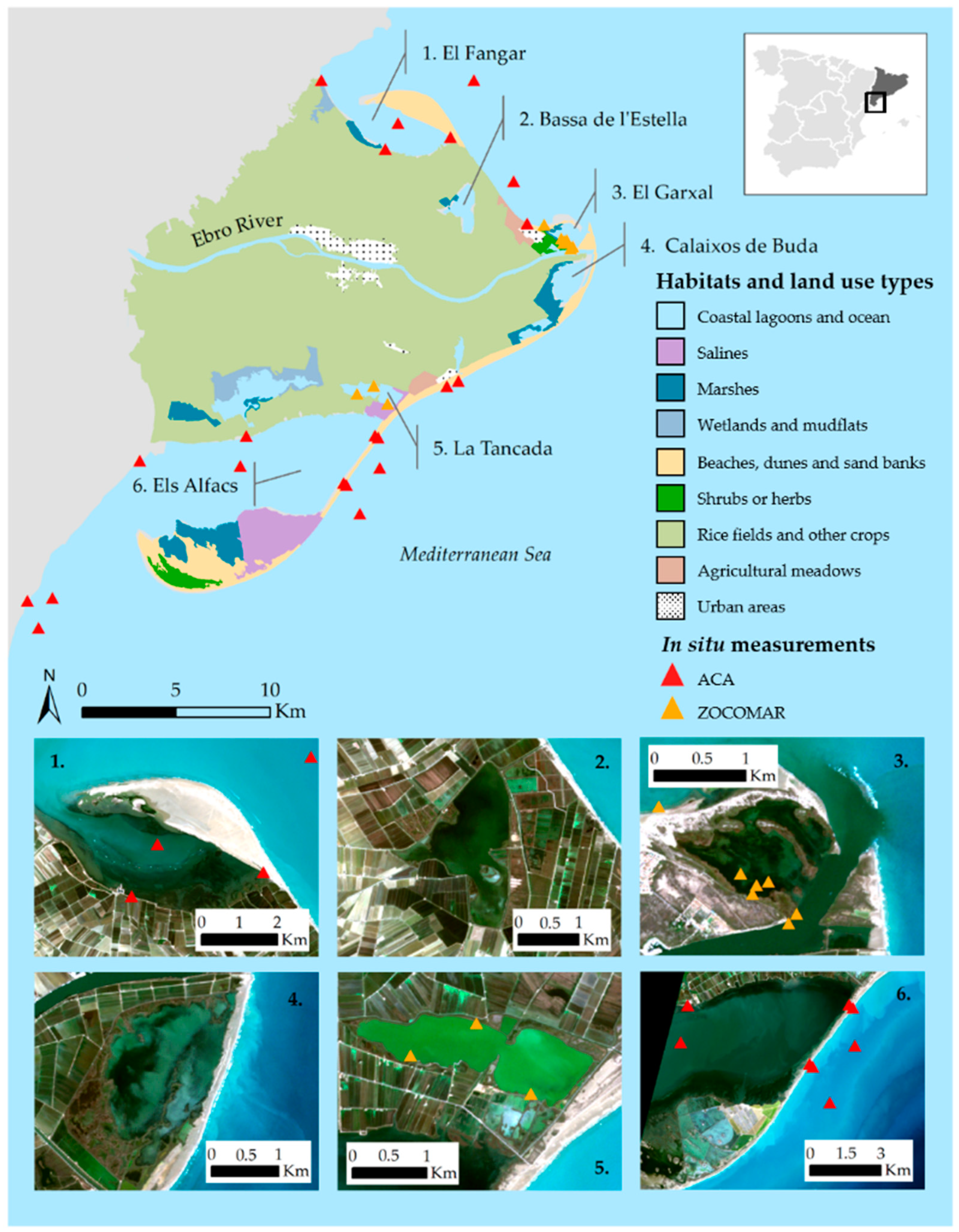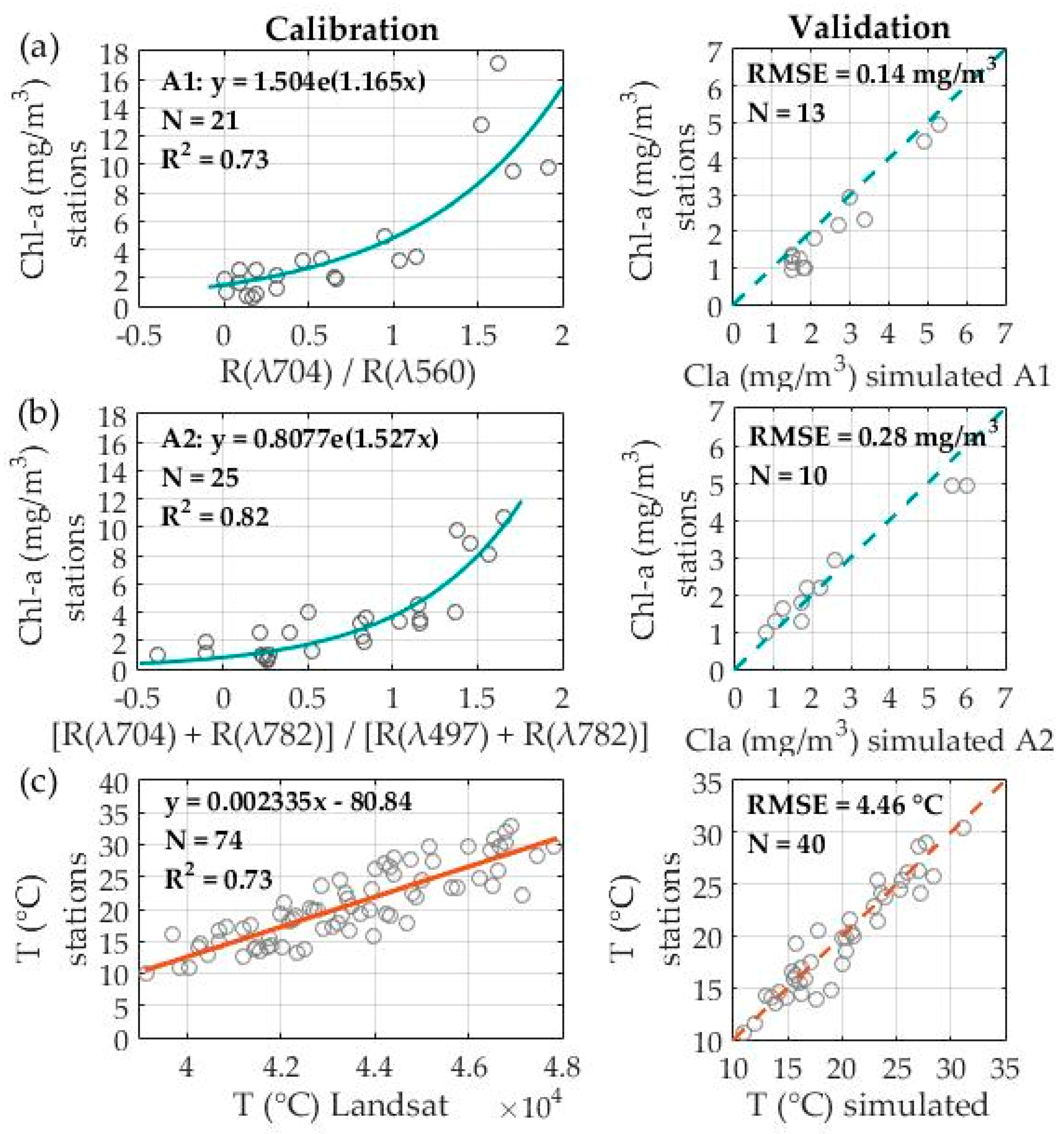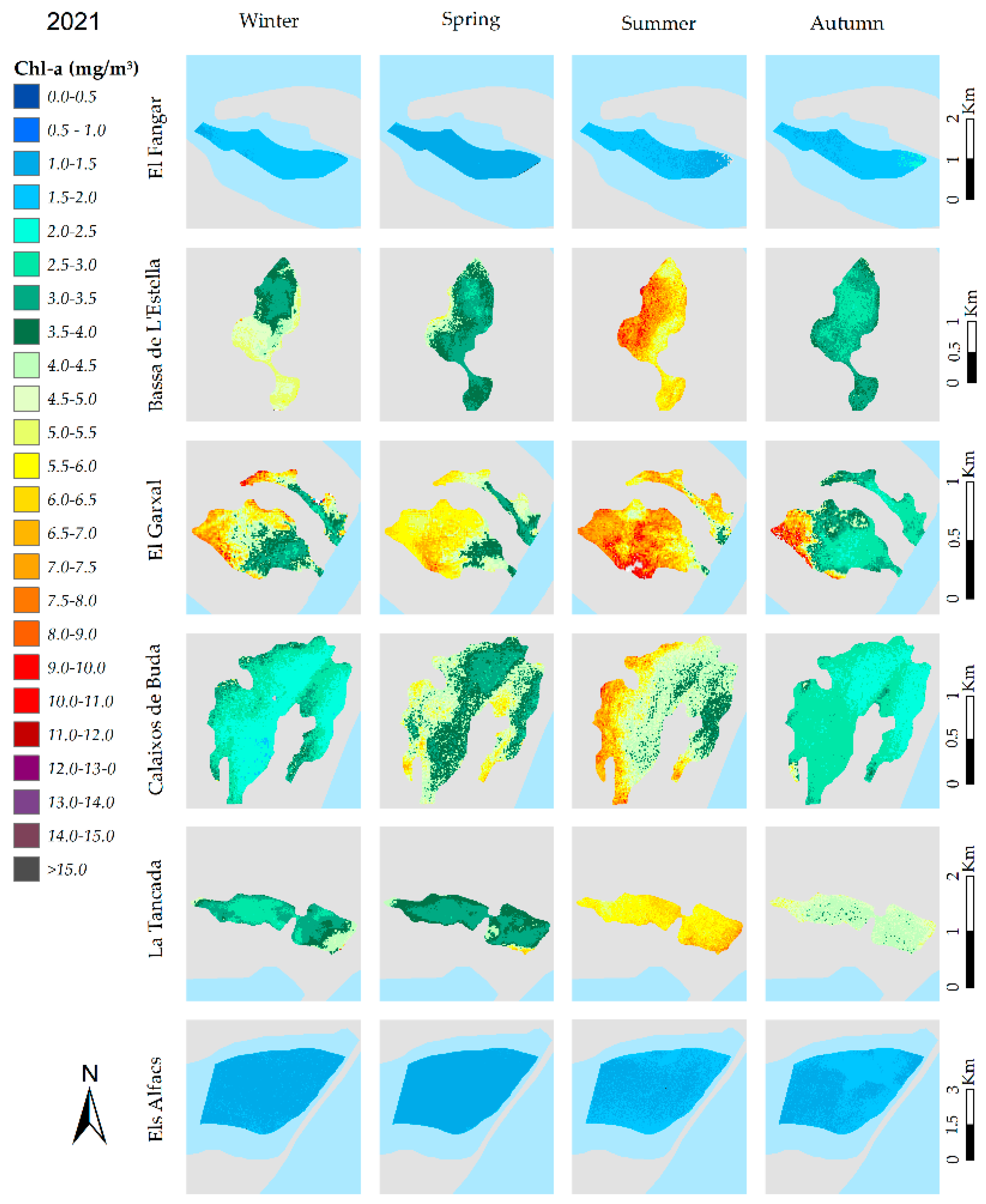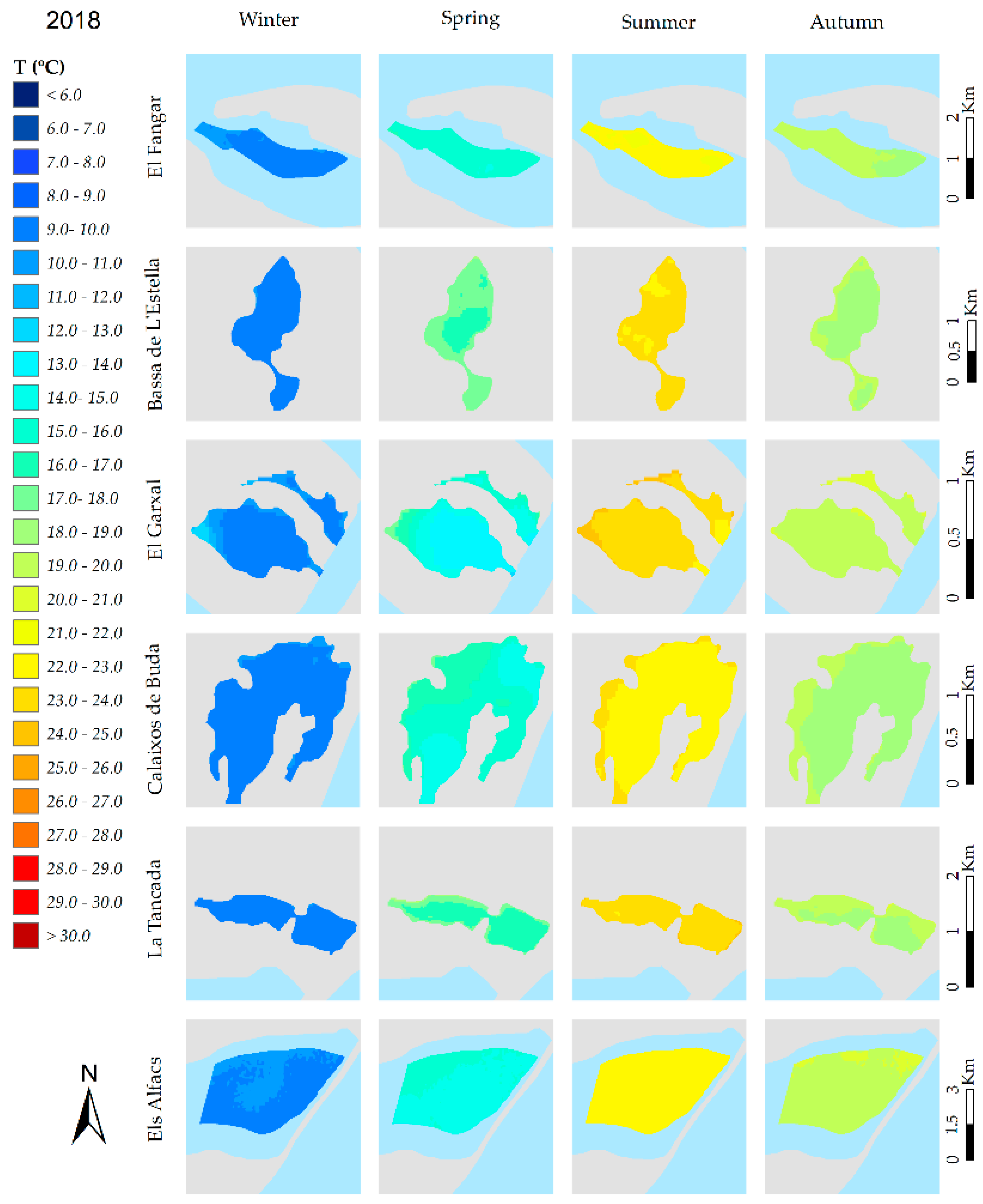Analysing Spatiotemporal Variability of Chlorophyll-a Concentration and Water Surface Temperature in Coastal Lagoons of the Ebro Delta (NW Mediterranean Sea, Spain)
Abstract
:1. Introduction
2. Materials and Methods
2.1. The Ebro Delta
2.2. Satellite Images
2.3. Collection of In Situ Data
2.4. Algorithm Development
2.5. Computing Maps of Chlorophyll-a Concentration and Water Surface Temperature
2.6. Analyses of Chlorophyll-a Concentration and Surface Water Temperature
3. Results
3.1. Algorithm Performance
3.2. Evolution of Chl-a Concentration in the Coastal Lagoons
3.3. Evolution of Water Surface Temperature in the Coastal Lagoons
4. Discussion
4.1. The Preliminary Algorithms Effectively Identified Variations in Chl-a Concentration and Surface Temperature within the Ebro Delta’s Coastal Lagoons and Bays
4.2. Factors Influencing the Variability of Chl-a Concentration and Temperature in the Ebro Delta’s Coastal Lagoons
4.3. Methodological Considerations
5. Conclusions
Supplementary Materials
Author Contributions
Funding
Institutional Review Board Statement
Informed Consent Statement
Data Availability Statement
Acknowledgments
Conflicts of Interest
References
- The Millennium Ecosystem Assessment. Ecosystems and Human Well-Being: Wetlands and Water; World Resources Institute: Washington, DC, USA, 2005; ISBN 1569735972. [Google Scholar]
- Loureiro, S.; Newton, A.; Icely, J. Boundary conditions for the European Water Framework Directive in the Ria Formosa lagoon, Portugal (physico-chemical and phytoplankton quality elements). Estuar. Coast. Shelf Sci. 2006, 67, 382–398. [Google Scholar] [CrossRef]
- Santos, R.; Silva, J.; Alexandre, A.; Navarro, N.; Barrón, C.; Duarte, C.M. Ecosystem metabolism and carbon fluxes of a tidally-dominated coastal lagoon. Estuaries 2004, 27, 977–985. [Google Scholar] [CrossRef]
- Newton, A.; Brito, A.C.; Icely, J.D.; Derolez, V.; Clara, I.; Angus, S.; Schernewski, G.; Inácio, M.; Lillebø, A.I.; Sousa, A.I. Assessing, quantifying and valuing the ecosystem services of coastal lagoons. J. Nat. Conserv. 2018, 44, 50–65. [Google Scholar] [CrossRef]
- Rodrigues-Filho, J.L.; Macêdo, R.L.; Sarmento, H.; Pimenta, V.R.A.; Alonso, C.; Teixeira, C.R.; Pagliosa, P.R.; Netto, S.A.; Santos, N.C.L.; Daura-Jorge, F.G. From ecological functions to ecosystem services: Linking coastal lagoons biodiversity with human well-being. Hydrobiologia 2023, 850, 2611–2653. [Google Scholar] [CrossRef]
- Garrido, J.; Pérez-Bilbao, A.; João Benetti, C. Biodiversity and conservation of coastal lagoons. In Ecosystems Biodiversity; IntechOpen: London, UK, 2011. [Google Scholar]
- Llebot, C.; Solé, J.; Delgado, M.; Fernández-Tejedor, M.; Camp, J.; Estrada, M. Hydrographical forcing and phytoplankton variability in two semi-enclosed estuarine bays. J. Mar. Syst. 2011, 86, 69–86. [Google Scholar] [CrossRef]
- Brito, A.C.; Newton, A.; Tett, P.; Fernandes, T.F. How will shallow coastal lagoons respond to climate change? A modelling investigation. Estuar. Coast. Shelf Sci. 2012, 112, 98–104. [Google Scholar] [CrossRef]
- F-Pedrera Balsells, M.; Grifoll, M.; Fernandez-Tejedor, M.; Espino, M. Short-Term Response of Chlorophyll a Concentration Due to Intense Wind and Freshwater Peak Episodes in Estuaries: The Case of Fangar Bay (Ebro Delta). Water 2021, 13, 701. [Google Scholar] [CrossRef]
- Kurylyk, B.L.; Smith, K.A. Stuck in the middle: Thermal regimes of coastal lagoons and estuaries in a warming world. Environ. Res. Lett. 2023, 18, 61003. [Google Scholar] [CrossRef]
- Newton, A.; Icely, J.; Cristina, S.; Brito, A.; Cardoso, A.C.; Colijn, F.; Dalla Riva, S.; Gertz, F.; Hansen, J.W.; Holmer, M. An overview of ecological status, vulnerability and future perspectives of European large shallow, semi-enclosed coastal systems, lagoons and transitional waters. Estuar. Coast. Shelf Sci. 2014, 140, 95–122. [Google Scholar] [CrossRef]
- Rodríguez-Santalla, I.; Navarro, N. Main threats in Mediterranean coastal wetlands. The Ebro Delta case. J. Mar. Sci. Eng. 2021, 9, 1190. [Google Scholar] [CrossRef]
- Zou, X.-Y.; Peng, X.-Y.; Zhao, X.-X.; Chang, C.-P. The impact of extreme weather events on water quality: International evidence. Nat. Hazards 2023, 115, 1–21. [Google Scholar] [CrossRef]
- Caballero, I.; Roca, M.; Dunbar, M.B.; Navarro, G. Water Quality and Flooding Impact of the Record-Breaking Storm Gloria in the Ebro Delta (Western Mediterranean). Remote Sens. 2023, 16, 41. [Google Scholar] [CrossRef]
- Jiang, D.; Hao, M.; Fu, J. Monitoring the coastal environment using remote sensing and GIS techniques. Appl. Stud. Coast. Mar. Environ. 2016, 2, 23–35. [Google Scholar]
- Klemas, V. Remote sensing techniques for studying coastal ecosystems: An overview. J. Coast. Res. 2011, 27, 2–17. [Google Scholar]
- El Mahrad, B.; Newton, A.; Icely, J.D.; Kacimi, I.; Abalansa, S.; Snoussi, M. Contribution of remote sensing technologies to a holistic coastal and marine environmental management framework: A review. Remote Sens. 2020, 12, 2313. [Google Scholar] [CrossRef]
- Guanter, L.; Ruiz-Verdú, A.; Odermatt, D.; Giardino, C.; Simis, S.; Estellés, V.; Heege, T.; Domínguez-Gómez, J.A.; Moreno, J. Atmospheric correction of ENVISAT/MERIS data over inland waters: Validation for European lakes. Remote Sens. Environ. 2010, 114, 467–480. [Google Scholar] [CrossRef]
- Gómez, J.A.D.; Alonso, C.A.; García, A.A. Remote sensing as a tool for monitoring water quality parameters for Mediterranean Lakes of European Union water framework directive (WFD) and as a system of surveillance of cyanobacterial harmful algae blooms (SCyanoHABs). Environ. Monit. Assess. 2011, 181, 317–334. [Google Scholar] [CrossRef]
- Delegido, J.; Tenjo, C.; Ruiz-Verdú, A.; Peña, R.; Moreno, J. Modelo empírico para la determinación de clorofila-a en aguas continentales a partir de los futuros Sentinel-2 y 3. Validación con imágenes HICO. Rev. Teledetec. 2014, 41, 37–47. [Google Scholar] [CrossRef]
- Laneve, G.; Téllez, A.; Kallikkattil Kuruvila, A.; Bruno, M.; Messineo, V. Eutrophication and HAB Occurrence Control in Lakes of Different Origins: A Multi-Source Remote Sensing Detection Strategy. Remote Sens. 2024, 16, 1792. [Google Scholar] [CrossRef]
- Erena, S.H.; Worku, H. Urban flood vulnerability assessments: The case of Dire Dawa city, Ethiopia. Nat. Hazards 2019, 97, 495–516. [Google Scholar] [CrossRef]
- Galešić Divić, M.; Kvesić Ivanković, M.; Divić, V.; Kišević, M.; Panić, M.; Lugonja, P.; Crnojević, V.; Andričević, R. Estimation of Water Quality Parameters in Oligotrophic Coastal Waters Using Uncrewed-Aerial-Vehicle-Obtained Hyperspectral Data. J. Mar. Sci. Eng. 2023, 11, 2026. [Google Scholar] [CrossRef]
- Soriano-González, J.; Angelats, E.; Fernández-Tejedor, M.; Diogene, J.; Alcaraz, C. First results of phytoplankton spatial dynamics in two NW-Mediterranean bays from chlorophyll-a estimates using Sentinel 2: Potential implications for aquaculture. Remote Sens. 2019, 11, 1756. [Google Scholar] [CrossRef]
- Fernández-Tejedor, M.; Velasco, J.E.; Angelats, E. Accurate estimation of Chlorophyll-a concentration in the coastal areas of the Ebro Delta (NW Mediterranean) using Sentinel-2 and its application in the selection of areas for mussel aquaculture. Remote Sens. 2022, 14, 5235. [Google Scholar] [CrossRef]
- Ahmed, M.H.; El Leithy, B.M.; Thompson, J.R.; Flower, R.J.; Ramdani, M.; Ayache, F.; Hassan, S.M. Application of remote sensing to site characterisation and environmental change analysis of North African coastal lagoons. Hydrobiologia 2009, 622, 147–171. [Google Scholar] [CrossRef]
- Zoffoli, M.L.; Gernez, P.; Rosa, P.; Le Bris, A.; Brando, V.E.; Barillé, A.-L.; Harin, N.; Peters, S.; Poser, K.; Spaias, L. Sentinel-2 remote sensing of Zostera noltei-dominated intertidal seagrass meadows. Remote Sens. Environ. 2020, 251, 112020. [Google Scholar] [CrossRef]
- Jaud, M.; Delacourt, C.; Le Dantec, N.; Ammann, J.; Grandjean, P.; Allemand, P.; Cocquempot, L. Potential of imaging UAVs for coastal monitoring. In Remote Detection and Maritime Pollution: Chemical Spill Studies; Wiley: Hoboken, NJ, USA, 2021; pp. 133–142. [Google Scholar] [CrossRef]
- Diruit, W.; Le Bris, A.; Bajjouk, T.; Richier, S.; Helias, M.; Burel, T.; Lennon, M.; Guyot, A.; Ar Gall, E. Seaweed habitats on the shore: Characterization through hyperspectral UAV imagery and field sampling. Remote Sens. 2022, 14, 3124. [Google Scholar] [CrossRef]
- Timmer, B.; Reshitnyk, L.Y.; Hessing-Lewis, M.; Juanes, F.; Costa, M. Comparing the use of red-edge and near-infrared wavelength ranges for detecting submerged kelp canopy. Remote Sens. 2022, 14, 2241. [Google Scholar] [CrossRef]
- Mishra, S.; Stumpf, R.P.; Meredith, A. Evaluation of RapidEye data for mapping algal blooms in inland waters. Int. J. Remote Sens. 2019, 40, 2811–2829. [Google Scholar] [CrossRef]
- Caballero, I.; Fernández, R.; Escalante, O.M.; Mamán, L.; Navarro, G. New capabilities of Sentinel-2A/B satellites combined with in situ data for monitoring small harmful algal blooms in complex coastal waters. Sci. Rep. 2020, 10, 8743. [Google Scholar] [CrossRef]
- Soriano Gonzalez, J.; Fernández Tejedor, M.; Alcaraz, C. Combined flooding and water quality monitoring during short extreme events using Sentinel 2: The case study of Gloria storm in Ebro delta. ISPRS Ann. Photogramm. Remote Sens. Spat. Inf. Sci. 2022, 3, 361–368. [Google Scholar]
- Braga, F.; Scarpa, G.M.; Brando, V.E.; Manfè, G.; Zaggia, L. COVID-19 lockdown measures reveal human impact on water transparency in the Venice Lagoon. Sci. Total Environ. 2020, 736, 139612. [Google Scholar] [CrossRef]
- Genua-Olmedo, A.; Alcaraz, C.; Caiola, N.; Ibáñez, C. Sea level rise impacts on rice production: The Ebro Delta as an example. Sci. Total Environ. 2016, 571, 1200–1210. [Google Scholar] [CrossRef]
- Benito, X.; Trobajo, R.; Ibáñez, C. Benthic diatoms in a Mediterranean delta: Ecological indicators and a conductivity transfer function for paleoenvironmental studies. J. Paleolimnol. 2015, 54, 171–188. [Google Scholar] [CrossRef]
- Franquet Bernis, J.M.; Albacar Damian, M.A.; Tallada de Esteve, F. Problemática del Río Ebro en Su Tramo Final. Informe Acerca de los Efectos Sobre el Área Jurisdiccional de la Comunidad de Regantes–Sindicato Agrícola del Ebro; UNED-Tortosa: Tarragona, Spain, 2017. [Google Scholar]
- Cateura, J.; Sánchez-Arcilla, A.; Bolaños, R. Clima de viento en el delta del Ebro. Relación con el estado del mar. In El clima entre el mar y la montaña; García Codron, J.C., Diego Liaño, C., de Arróyabe Hernáez, P.F., Garmendia Pedraja, C., Rasilla Álvarez, D., Eds.; Asociación Española de Climatología: Santander, Spain, 2004; pp. 463–472. [Google Scholar]
- Aranda García, M.; Gracia Prieto, F.J.; Rodríguez-Santalla, I. Historical morphological changes (1956–2017) and future trends at the mouth of the Ebro River delta (NE Spain). Cuad. Investig. Geogr. 2022, 293–307. [Google Scholar] [CrossRef]
- Warren, M.A.; Simis, S.G.H.; Martinez-Vicente, V.; Poser, K.; Bresciani, M.; Alikas, K.; Spyrakos, E.; Giardino, C.; Ansper, A. Assessment of atmospheric correction algorithms for the Sentinel-2A MultiSpectral Imager over coastal and inland waters. Remote Sens. Environ. 2019, 225, 267–289. [Google Scholar] [CrossRef]
- García-Plazaola, J.I.; Becerril, J.M. Seasonal changes in photosynthetic pigments and antioxidants in beech (Fagus sylvatica) in a Mediterranean climate: Implications for tree decline diagnosis. Funct. Plant Biol. 2001, 28, 225–232. [Google Scholar] [CrossRef]
- López, J.; Arté, P. Hidrografía y fitoplancton del puerto del Fangar (delta del Ebro). Investig. Pesq. 1973, 37, 17–56. [Google Scholar]
- Delgado, M. Fitoplancton de las Bahías del Delta del Ebro. Investig. Pesq. 1987, 51, 517–548. [Google Scholar]
- Comín, F.A. Características físicas y químicas y fitoplancton de las lagunas costeras, Encañizada, Tancada y Buda (Delta del Ebro). Oecol. Aquat. 1984, 7, 79–162. [Google Scholar]
- Solé, J.; Turiel, A.; Estrada, M.; Llebot, C.; Blasco, D.; Camp, J.; Delgado, M.; Fernandez-Tejedor, M.; Diogene, J. Climatic forcing on hydrography of a Mediterranean bay (Alfacs Bay). Cont. Shelf Res. 2009, 29, 1786–1800. [Google Scholar] [CrossRef]
- Prado, P.; Caiola, N.; Ibáñez, C. Water management alters phytoplankton and zooplankton communities in Ebro delta coastal lagoons. Limnetica 2017, 36, 113–126. [Google Scholar]
- Cañedo-Argüelles, M.; Rieradevall, M.; Farrés-Corell, R.; Newton, A. Annual characterisation of four Mediterranean coastal lagoons subjected to intense human activity. Estuar. Coast. Shelf Sci. 2012, 114, 59–69. [Google Scholar] [CrossRef]
- Postma, H. Chemistry of coastal lagoons. In Lagunas Costeras, Simposio, Mem. Simp. Inter. Lagunas Costeras, UNAM/UNESCO; Pascal and Francis, Centre National de la Recherche Scientifique (Francia); Institut de l’Information Scientifique et Technique: Paris, France, 1969; pp. 421–430. [Google Scholar]
- Bramich, J.; Bolch, C.J.S.; Fischer, A. Improved red-edge chlorophyll-a detection for Sentinel 2. Ecol. Indic. 2021, 120, 106876. [Google Scholar] [CrossRef]
- Shang, S.; Lee, Z.; Lin, G.; Hu, C.; Shi, L.; Zhang, Y.; Li, X.; Wu, J.; Yan, J. Sensing an intense phytoplankton bloom in the western Taiwan Strait from radiometric measurements on a UAV. Remote Sens. Environ. 2017, 198, 85–94. [Google Scholar] [CrossRef]
- Román, A.; Heredia, S.; Windle, A.E.; Tovar-Sánchez, A.; Navarro, G. Enhancing Georeferencing and Mosaicking Techniques over Water Surfaces with High-Resolution Unmanned Aerial Vehicle (UAV) Imagery. Remote Sens. 2024, 16, 290. [Google Scholar] [CrossRef]







| Bands | Bands Combination | References |
|---|---|---|
| 2 | R(λ664)/R(λ560) | [25] |
| R(λ497)/R(λ560) | [25] | |
| R(λ704)/R(λ497) | [20,25] | |
| R(λ704)/R(λ560) | [20,25] | |
| R(λ704)/R(λ664) | [20,25] | |
| R(λ740)/R(λ560) | [25] | |
| 1/R(λ497) − 1/R(λ704) | [20] | |
| 1/R(λ560) − 1/R(λ704) | [20] | |
| 1/R(λ664) − 1/R(λ704) | [20] | |
| [R(λ497) − R(λ704)]/[R(λ497) + R(λ704)] | [20] | |
| [R(λ560) − R(λ704)]/[R(λ560) + R(λ704)] | [20] | |
| [R(λ664) − R(λ704)]/[R(λ664) + R(λ704)] | [20] | |
| [R(λ740) − R(λ704)]/[R(λ740) + R(λ704)] | [25], NDCI | |
| 3 | [R(λ704) × R(λ704)]/R(λ497) | [20] |
| [R(λ704) × R(λ704)]/R(λ664) | [20] | |
| [R(λ704)/[R(λ497)] × R(λ497)] | [20] | |
| [R(λ782)/[R(λ497)] × R(λ664)] | [20] | |
| [R(λ497) − R(λ704)]/R(λ497) | [20] | |
| [R(λ560) − R(λ704)]/R(λ664) | [20] | |
| [R(λ664) − R(λ704)]/R(λ664) | [20] | |
| [R(λ497) + R(λ704)]/R(λ497) | [20] | |
| [R(λ664) + R(λ704)]/R(λ664) | [20] | |
| [R(λ704) + R(λ704)]/R(λ664) | [20] | |
| [(R(λ497) – 1) − (R(λ704) – 1)] × R(λ704)] | [20] | |
| [(R(λ560) – 1) − (R(λ704) – 1)] × R(λ560)] | [20] | |
| [(R(λ664) – 1) − (R(λ704) – 1)] × R(λ704)] | [20] | |
| 4 | [R(λ560) + R(λ704)]/[R(λ560) + R(λ664)] | [20] |
| [R(λ704) + R(λ782)]/[R(λ497) + R(λ782)] | [20] | |
| [R(λ704) + R(λ782)]/[R(λ560) + R(λ782)] | [20] | |
| [R(λ497) − R(λ704)]/[R(λ497) + R(λ782)] | [20] | |
| [R(λ560) − R(λ704)]/[R(λ664) + R(λ782)] | [20] | |
| [R(λ664) − R(λ704)]/[R(λ664) + R(λ782)] | [20] | |
| [R(λ407) − R(λ560)]/[R(λ560) − R(λ782)] | [20] | |
| [R(λ664) − R(λ704)]/[R(λ497) − R(λ560)] | [20] | |
| [R(λ704)/ R(λ497)] + [R(λ704)/ R(λ560)] | [20] | |
| [R(λ560)/ R(λ704)] − [R(λ704)/ R(λ497)] | [20] | |
| [R(λ664)/ R(λ560)] − [R(λ704)/ R(λ560)] | [20] | |
| [R(λ497) + R(λ560) + R(λ782)]/R(λ704) | [20] | |
| [R(λ560) + R(λ664) + R(λ664)]/R(λ704) | [20] |
| Index Bands Combination | References | Model Fit | N(C/V) | R2 | RMSE (mg/m3) | Name |
|---|---|---|---|---|---|---|
| R(λ704)/R(λ560) | [20,25] | Exponential | 34 (21/13) | 0.73 | 0.14 | A1 |
| [R(λ704) + R(λ782)]/[R(λ497) + R(λ782)] | [20] | Exponential | 35 (25/10) | 0.82 | 0.28 | A2 |
Disclaimer/Publisher’s Note: The statements, opinions and data contained in all publications are solely those of the individual author(s) and contributor(s) and not of MDPI and/or the editor(s). MDPI and/or the editor(s) disclaim responsibility for any injury to people or property resulting from any ideas, methods, instructions or products referred to in the content. |
© 2024 by the authors. Licensee MDPI, Basel, Switzerland. This article is an open access article distributed under the terms and conditions of the Creative Commons Attribution (CC BY) license (https://creativecommons.org/licenses/by/4.0/).
Share and Cite
Talavera, L.; Domínguez-Gómez, J.A.; Navarro, N.; Rodríguez-Santalla, I. Analysing Spatiotemporal Variability of Chlorophyll-a Concentration and Water Surface Temperature in Coastal Lagoons of the Ebro Delta (NW Mediterranean Sea, Spain). J. Mar. Sci. Eng. 2024, 12, 941. https://doi.org/10.3390/jmse12060941
Talavera L, Domínguez-Gómez JA, Navarro N, Rodríguez-Santalla I. Analysing Spatiotemporal Variability of Chlorophyll-a Concentration and Water Surface Temperature in Coastal Lagoons of the Ebro Delta (NW Mediterranean Sea, Spain). Journal of Marine Science and Engineering. 2024; 12(6):941. https://doi.org/10.3390/jmse12060941
Chicago/Turabian StyleTalavera, Lara, José Antonio Domínguez-Gómez, Nuria Navarro, and Inmaculada Rodríguez-Santalla. 2024. "Analysing Spatiotemporal Variability of Chlorophyll-a Concentration and Water Surface Temperature in Coastal Lagoons of the Ebro Delta (NW Mediterranean Sea, Spain)" Journal of Marine Science and Engineering 12, no. 6: 941. https://doi.org/10.3390/jmse12060941





